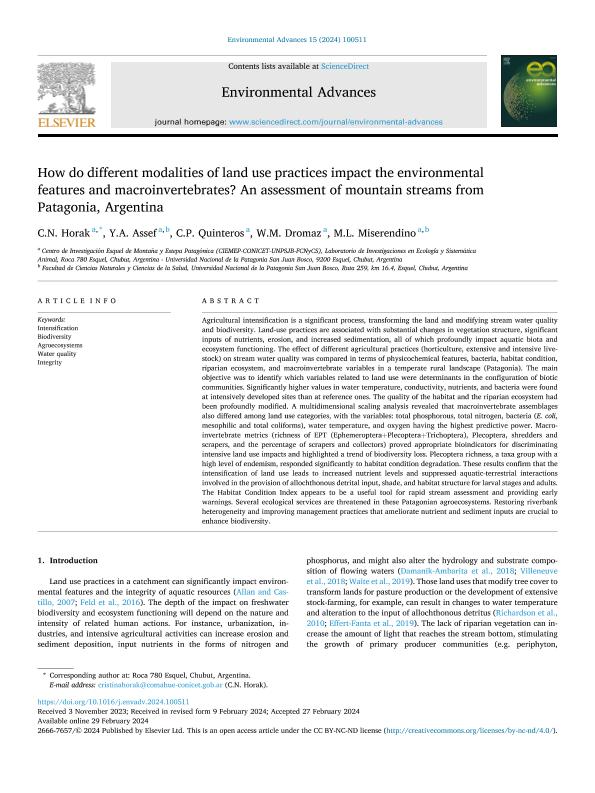Artículo
How do different modalities of land use practices impact the environmental features and macroinvertebrates? An assessment of mountain streams from Patagonia, Argentina
Horak, Cristina Natalia ; Assef, Yanina Andrea
; Assef, Yanina Andrea ; Quinteros, Claudia Pamela
; Quinteros, Claudia Pamela ; Dromaz, Walter Mauricio
; Dromaz, Walter Mauricio ; Miserendino, Maria Laura
; Miserendino, Maria Laura
 ; Assef, Yanina Andrea
; Assef, Yanina Andrea ; Quinteros, Claudia Pamela
; Quinteros, Claudia Pamela ; Dromaz, Walter Mauricio
; Dromaz, Walter Mauricio ; Miserendino, Maria Laura
; Miserendino, Maria Laura
Fecha de publicación:
04/2024
Editorial:
Elsevier
Revista:
Environmental Advances
ISSN:
2666-7657
Idioma:
Inglés
Tipo de recurso:
Artículo publicado
Clasificación temática:
Resumen
Agricultural intensification is a significant process, transforming the land and modifying stream water quality and biodiversity. Land-use practices are associated with substantial changes in vegetation structure, significant inputs of nutrients, erosion, and increased sedimentation, all of which profoundly impact aquatic biota and ecosystem functioning. The effect of different agricultural practices (horticulture, extensive and intensive livestock) on stream water quality was compared in terms of physicochemical features, bacteria, habitat condition, riparian ecosystem, and macroinvertebrate variables in a temperate rural landscape (Patagonia). The main objective was to identify which variables related to land use were determinants in the configuration of bioticcommunities. Significantly higher values in water temperature, conductivity, nutrients, and bacteria were found at intensively developed sites than at reference ones. The quality of the habitat and the riparian ecosystem had been profoundly modified. A multidimensional scaling analysis revealed that macroinvertebrate assemblages also differed among land use categories, with the variables: total phosphorous, total nitrogen, bacteria (E. coli, mesophilic and total coliforms), water temperature, and oxygen having the highest predictive power. Macroinvertebrate metrics (richness of EPT (Ephemeroptera+Plecoptera+Trichoptera), Plecoptera, shredders and scrapers, and the percentage of scrapers and collectors) proved appropriate bioindicators for discriminatingintensive land use impacts and highlighted a trend of biodiversity loss. Plecoptera richness, a taxa group with a high level of endemism, responded significantly to habitat condition degradation. These results confirm that the intensification of land use leads to increased nutrient levels and suppressed aquatic-terrestrial interactions involved in the provision of allochthonous detrital input, shade, and habitat structure for larval stages and adults. The Habitat Condition Index appears to be a useful tool for rapid stream assessment and providing early warnings. Several ecological services are threatened in these Patagonian agroecosystems. Restoring riverbank heterogeneity and improving management practices that ameliorate nutrient and sediment inputs are crucial toenhance biodiversity.
Archivos asociados
Licencia
Identificadores
Colecciones
Articulos(CIEMEP)
Articulos de CENTRO DE INVESTIGACION ESQUEL DE MONTAÑA Y ESTEPA PATAGONICA
Articulos de CENTRO DE INVESTIGACION ESQUEL DE MONTAÑA Y ESTEPA PATAGONICA
Citación
Horak, Cristina Natalia; Assef, Yanina Andrea; Quinteros, Claudia Pamela; Dromaz, Walter Mauricio; Miserendino, Maria Laura; How do different modalities of land use practices impact the environmental features and macroinvertebrates? An assessment of mountain streams from Patagonia, Argentina; Elsevier; Environmental Advances; 15; 4-2024; 1-12
Compartir
Altmétricas



